of the Ottoman Empire
|
 |
The seventeenth century had been a period of instability for the Ottoman currency culminating around the middle of the century in the closure of Ottoman mints, the cessation of the production of silver akches and their use as a means of exchange. The decline of the akche posed serious challenges to the Ottoman administration. Without control over the currency, its control over the economy diminished considerably. Moreover, the disintegration of the monetary system and the increasing reliance on foreign coins had serious political implications. During the second half of the seventeenth century the government thus made numerous attempts at establishing a new currency but these proved to be unsuccessful due to the continuation of wars and fiscal difficulties. After a long interval of inactivity, the mint in Istanbul resumed operations in 1685, producing the small akches and the copper mangir beginning in 1689. Supported by the revenues from this experiment, the government then renewed its efforts to establish a new system around a large silver unit modelled after the European coins circulating in the Ottoman markets since the middle of the sixteenth century.
The first large silver coins were minted in 1690 after the Polish coin isolette or zolota which was imported in large quantities by Dutch merchants during the seventeenth century. These coins were about one third smaller than the Dutch thalers.[1] Their weight was fixed in standard dirhams (3,20 grams) and they contained 60 percent silver and 40 percent copper. The largest of these weighed 6 dirhams, or approximately 19.2 grams. Later, in 1703, an even larger coin weighing approximately 8 dirhams, or 25-26 grams and its fractions were also minted. It appears that the first large coin of 1690 was intended as a zolota or cedid (new) zolota to distinguish it from the popular Polish coin and not as a gurush or piaster.[2] Only after larger silver coins began to be minted in the early decades of the eighteenth century, was the new monetary scale clearly established. The new Ottoman gurush was then fixed at 120 akches or 40 paras. The early gurushes weighed six and a quarter dirhams (20.0 grams) and contained close to 60 percent silver. The zolotas were valued at three fourths of the gurush or at 90 akches. The fractions of both the gurush and zolota were then minted accordingly.[3] Due to wars and continuing political turmoil, however, many coins were minted with sub-standard silver content until the monetary reform of 1715-16. The appearance of sub-standard coinage attracted large numbers of counterfeiters until the 1720s.
| Gold | Tuğra / Duribe fi İslâmbol 1115* diameter: 24 mm weight: 3.35 g |
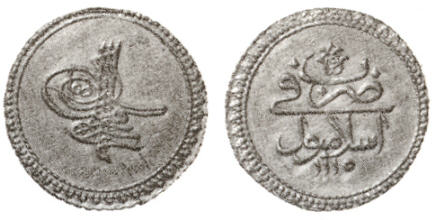 |
|||
| Zeri Mahbub Sultanül berreyni [...]/ Tuğra, azze nasrühü düribe fi İslâmbol 1115* diameter: 18 mm weight: 2.60 g |
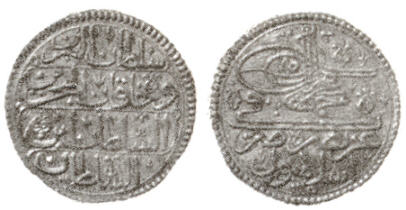 |
||||
| Silver | Gurush = 40 paras Sultanül berreyni [...]/ Tuğra, duribe fi Kostantiniye 1115 diameter: 40 mm weight: 25.65 g |
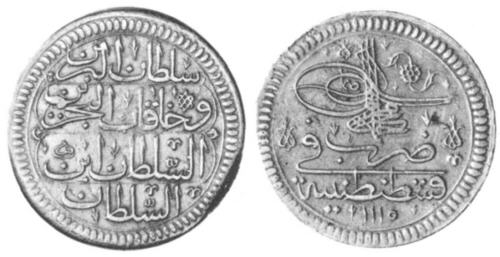 |
|||
| Zolota = 30 paras Sultanül berreyni [...]/ Tuğra, duribe fi Kostantiniye 1115 diameter: 39 mm weight: 19.60 g |
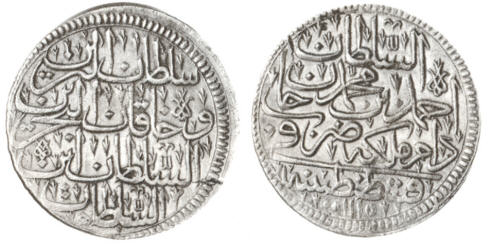 |
||||
| Yirmilik "piece of 20" = 20 paras Sultanül berreyni [...]/ Tuğra, duribe fi Kostantiniye 1115 diameter: 34 mm weight: 12.68 g |
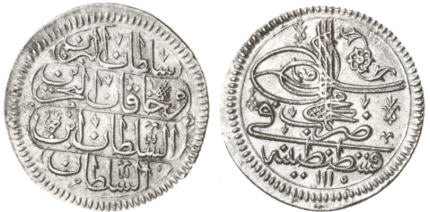 |
||||
| Para = 3 Akches Tuğra / Duribe fi Kostantiniye 1115 diameter: 15 mm weight: 0.55 g |
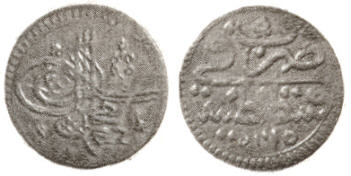 |
||||
| Akçe Tuğra / Duribe fi Kostantiniye 1115 diameter: 11 mm weight: 0.20 g |
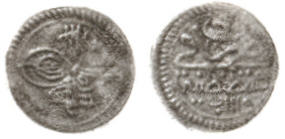 |
||||
|
|||||
By the 1720s a full spectrum of silver coinage had emerged from the gurush down to the para and the tiny akche. While the gurush, zolota and the 20 para piece were used for medium and larger transactions, 1, 5 and 10 para pieces served as petty coinage. By this time, the purchasing power of the akche, valued at one-third of the para, had become too small for most daily purposes.[4] For this reason, the para, more than the akche, served as the basic unit of account for small transactions. In addition, some copper coinage were minted in Istanbul and eastern Anatolia but their volumes were limited.
As for gold coins, the Ottoman sultani, or sherifi as it was also called, which had remained close to the standards of the Venetian ducat since the fifteenth century was discontinued late in the seventeenth century. In the early part of the eighteenth century, as gold made a comeback in Europe and elsewhere, Ottoman minting activity also resumed. In the place of the sultani, a number of new gold coins called tughrali, cedid Istanbul, zincirli, findik and zer-i mahbub were initiated between 1697 and 1728. All but the last of these started close to the standards of the ducat. Following the practice dating back to the fifteenth century, the government did not attach a fixed face value to these gold coins. Their exchange rates were determined by the markets. In payments to the state, gold coins were accepted at the official rates of exchange.
The eighteenth century until the 1780s was a period of commercial and economic expansion coupled with fiscal stability in most parts of the Ottoman Empire. These favorable conditions as well as the rising supplies of silver helped establish the gurush as the leading unit of account and means of exchange by the middle of the eighteenth century. The emergence of the new unit was accompanied by centralization of mint activity in the core regions of the empire, from the Balkans to Anatolia, as well as Syria and Iraq.
Şevket ![]()
Pamuk, Şevket, A Monetary History of the Ottoman Empire (Cambridge: Cambridge University Press, 2000).